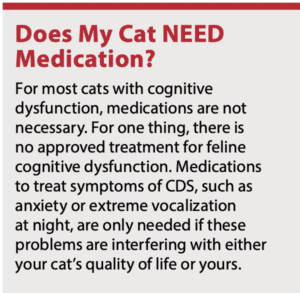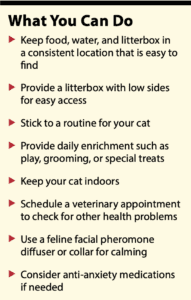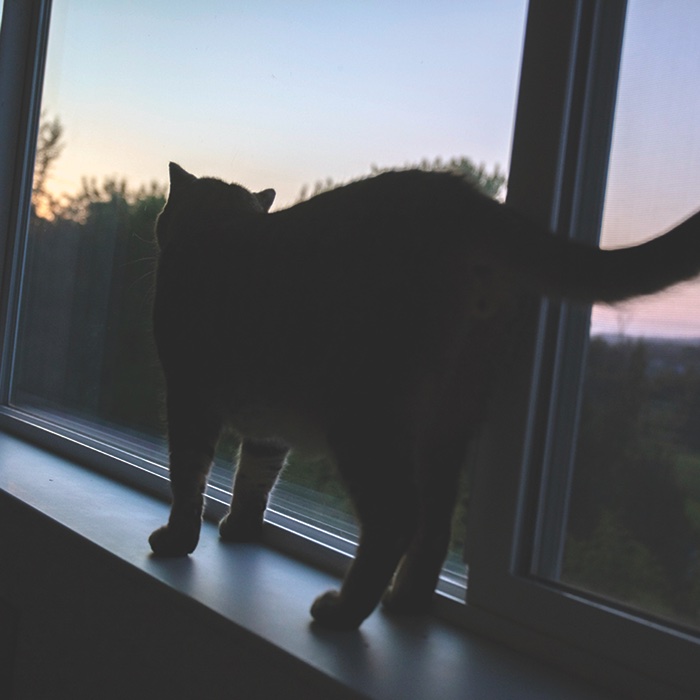If you’ve had a senior cat who started acting oddly, you may have wondered: Can cats get dementia? Yes, they can.
Symptoms
The veterinary term for age-related cognitive and behavioral changes in cats is feline cognitive dysfunction syndrome. This disorder is usually noticed in cats in their teens, but age of onset can vary.
“Because this is a disease of aged cats, it is important to address any concurrent medical issues, particularly those related to pain,” says Pamela J. Perry, DVM, PhD, behavior resident at Cornell University’s College of Veterinary Medicine. Your cat may just be suffering from cognitive dysfunction, but some of her behavioral changes could be due to other illnesses.
Dr. Perry says common signs of feline cognitive dysfunction include:
Altered social interactions, including increased “neediness” or affection toward owners
Increased vocalization
House soiling
Altered or aimless activity
Changes in the sleep-wake cycle
Increased anxiety
If you notice your cat experiencing any of these changes, schedule an appointment with your veterinarian.
Ruling Out Other Issues
Many different health conditions can cause the same symptoms as feline cognitive dysfunction syndrome. Your veterinarian will need to determine if your cat has just one health problem or several, and then choose a treatment plan appropriate for your cat’s case.
A physical exam and bloodwork are a great place to start to quickly identify or rule out a variety of common senior cat ailments, including diabetes, hyperthyroidism, and chronic kidney disease. If your cat does have one of these problems, she will be treated accordingly.
Your veterinarian will palpate the limbs and back to check for signs of pain, and may recommend X-rays to check for arthritis. Sometimes pain alone is responsible for a cat behaving strangely.
If your cat is urinating and/or defecating outside of her litterbox, a urinalysis and/or fecal evaluation may explain why. Urinalysis will check for signs of urinary tract infection, crystals or stones in the urinary tract, and/or kidney problems that might be contributing to house soiling, and a fecal exam will screen for parasites and other GI problems.
If your cat’s aimless wandering and disorientation are accompanied by additional neurological signs, a consultation with a neurologist may be in order. Some signs that are concerning include walking in circles, falling over, head pressing against walls or furniture, and sudden blindness. Depending on your cat’s exact symptoms, an MRI may be recommended to look at her brain.
There is no test for feline cognitive dysfunction. Instead, a diagnosis is made by considering everything that is going on in your cat’s life and by ruling out other health problems.
Helping Your Cat at Home
Many environmental management strategies can help your cat with cognitive dysfunction (or any senior cat!).
“Catering to the cat’s changing needs is important, such as providing lower-sided litterboxes that are more easily accessible,” says Dr. Perry. “Ramps to preferred elevated resting areas can also aid cats with joint or other mobility issues. In addition, a heated cat bed can provide additional comfort to an older kitty.”
Keep your cat on regular routines, with scheduled feedings, grooming, and other care so that she knows what to expect. These routines can be very helpful in preventing disorientation in cats with cognitive dysfunction.
“For cats who are active during the night, owners can try increasing their evening activity,” recommends Dr. Perry. Find a toy that your cat likes, or toss some treats for her to chase, and make this playtime part of your routine before bed. Start slow. While you do want your cat to burn some energy so she will sleep through the night, you do not want her to overdo it and be sore afterward.
If your cat seems to get lost in the house, move her litterbox, food, and water to locations that are easy for her to locate and access. It may be necessary to confine your cat to one or two rooms or even a large dog crate if she is having trouble finding the things she needs.
Consider using a feline facial pheromone diffuser or collar. These products can help to calm cats and may alleviate some of the anxiety that can come with cognitive dysfunction. A pheromone diffuser may also be helpful for guiding your cat to the location of key resources like food, water, and litterbox.
Medications
“Unfortunately, there are no FDA-approved medications for treatment of cognitive dysfunction in cats,” says Dr. Perry. Selegiline is a medication approved for use in dogs with cognitive dysfunction, and it has been used in some cats. This is a prescription medication that can interact with a variety of other medications, so your veterinarian will be cautious about using it for your cat.
Even though there are no medications that specifically target cognitive dysfunction, there are options that can help provide relief for your cat.
“If a cat has increased anxiety, then a selective serotonin reuptake inhibitor (SSRI) medication can be helpful,” says Dr. Perry. Fluoxetine is a commonly used SSRI for cats. “For cats who are active during the nighttime hours, other medications, like trazodone, may be useful in helping them sleep through the night.”
Most cats are simply treated with environmental management and tender loving care.
 Progressive Decline
Progressive Decline
Just as with Alzheimer’s disease in humans, feline cognitive dysfunction is a progressive disorder. This means that affected cats will usually get worse over time.
While we recommend that all pet cats be kept indoors, this is essential for cats with cognitive dysfunction. It is very easy for these cats to become disoriented and wander off, unable to find their way home.
How quickly CDS progresses will vary from cat to cat. Some veterinarians feel that supplementing with vitamin E, antioxidants, and SAM-e can help, but there is little scientific research on these options at this time.
 Prevention
Prevention
We do not know the cause of cognitive dysfunction syndrome, which means we also don’t have any sure-fire way to prevent it. However, studies have shown that environmental enrichment can be helpful to promote a healthy brain.
Enrichment activities can—and should!—start when your cat is a kitten. Provide your kitten with plenty of new toys and experiences to keep her physically and mentally stimulated. Building a catio or playing bird videos are two examples, and more options are covered in the February 2024 issue of Cornell CatWatch.
Continue enrichment throughout your cat’s life, adjusting for her age and evolving interests. Teaching your cat tricks is something that you can do at any age. Start with something simple, like fetch for a kitten, then teach your young adult cat to sit and jump. As your cat enters her senior years, adjust her tricks to things that are easy for her to do physically.

If your cat starts exhibiting abnormal behavior, such as being needy when aloof was previously more his thing, it could be a sign of dementia.
Cats of all ages will likely enjoy puzzle toys that dispense food. Rotate between different styles of puzzle toy to keep your cat engaged. As her cognition declines, stick to toys and games that she has played with before so that she does not become distressed by change.
Pamela J. Perry, DVM, PhD, is a behavior resident at Cornell University’s College of Veterinary Medicine.




